MARK 101: Analyzing Uber's Marketing Strategy, Market Segmentation
VerifiedAdded on 2023/06/11
|10
|2145
|382
Report
AI Summary
This report provides an in-depth analysis of Uber's marketing strategies, focusing on market positioning, segmentation, and development. It examines Uber's perceptual map, highlighting its competitive standing and the need for service quality improvements. The report explores Uber's positioning and differentiation strategies, emphasizing its pricing approach and target market. Segmentation strategies, including demographic, behavioral, psychographic, and geographic factors, are analyzed to identify customer needs in Wellington. The report also discusses market development strategies for sustainable growth and diversification approaches to enhance competitive advantages. Recommendations are made for product and service differentiation, leveraging the marketing mix to attract and retain customers in the global market. The analysis concludes with the importance of differentiation, segmentation, and positioning strategies for Uber's success in new markets.
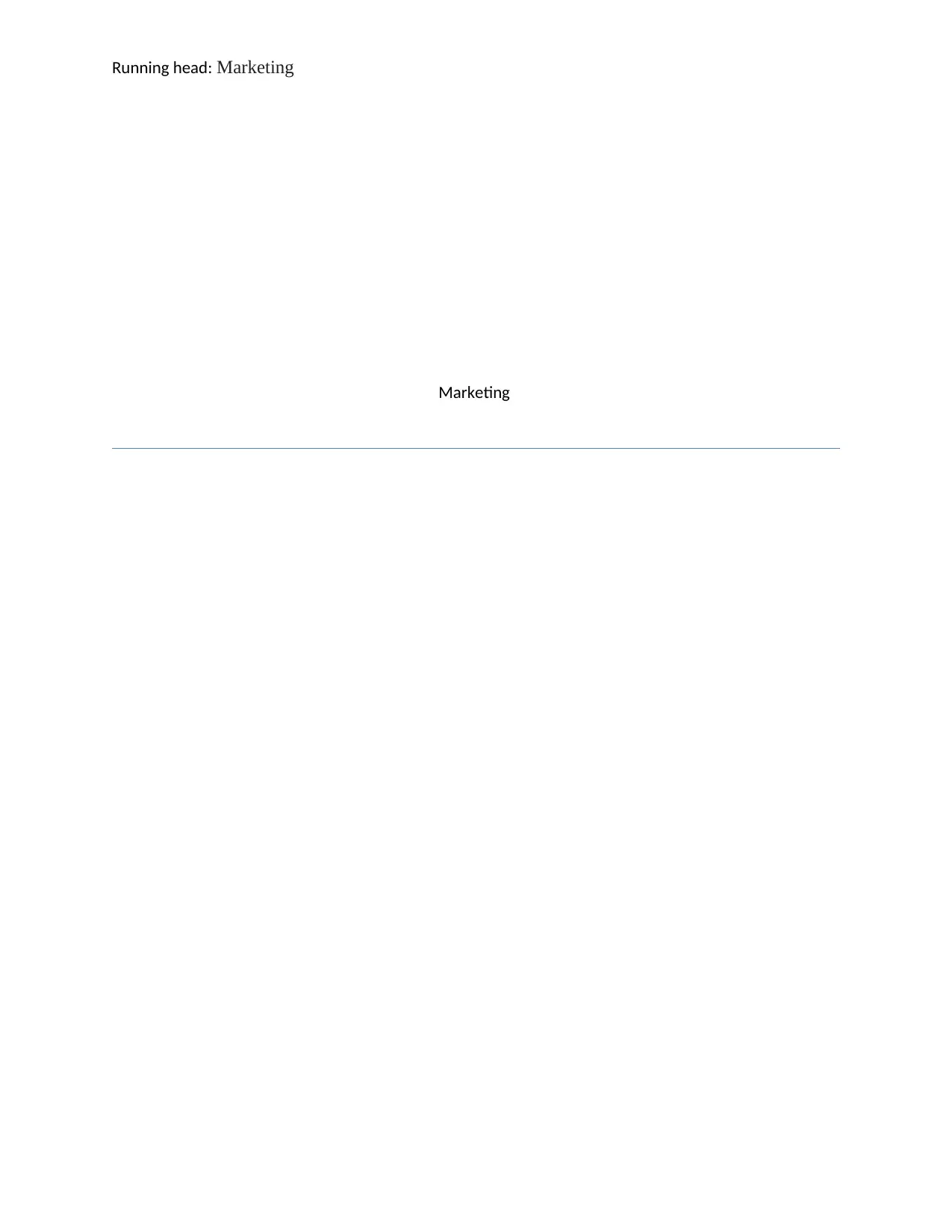
Running head: Marketing
Marketing
Marketing
Paraphrase This Document
Need a fresh take? Get an instant paraphrase of this document with our AI Paraphraser
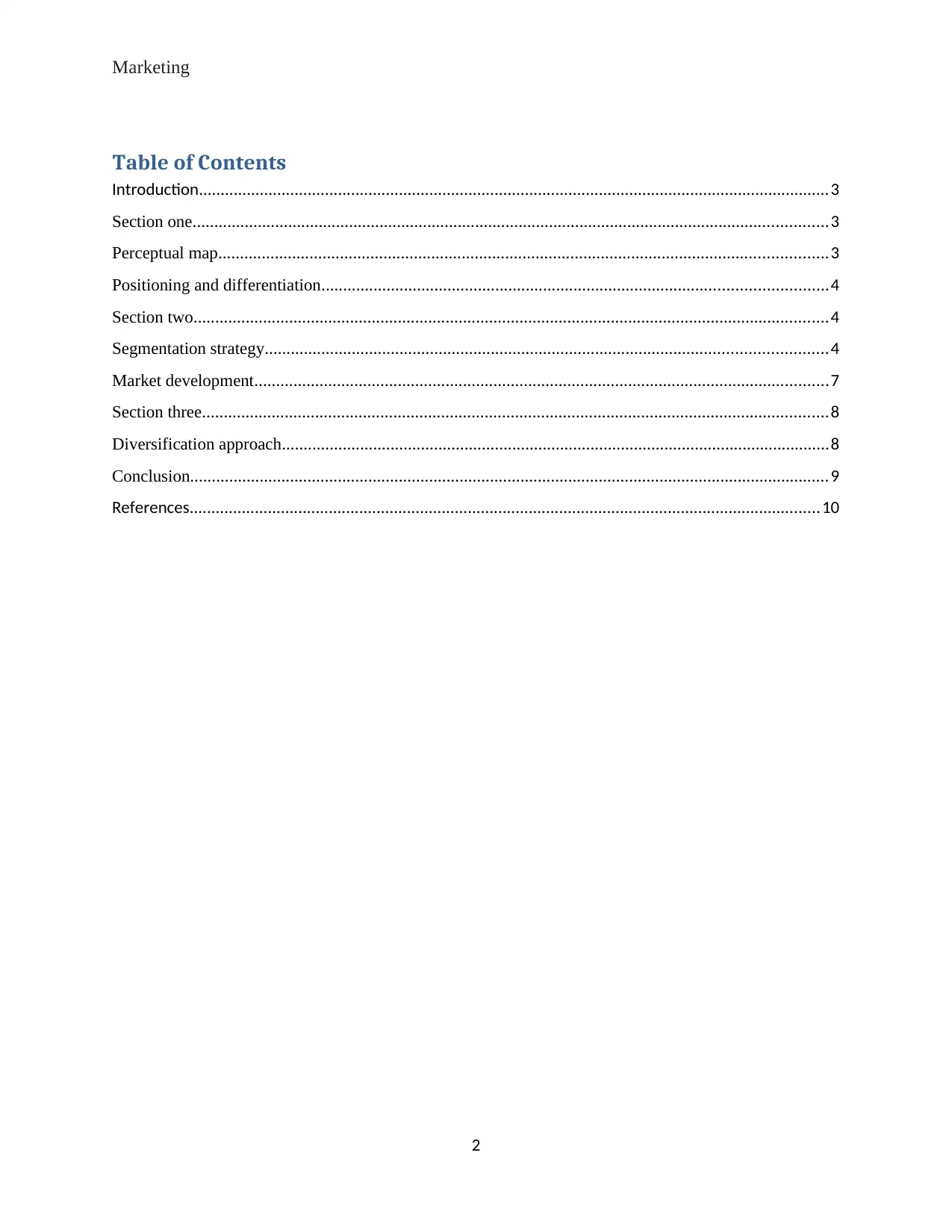
Marketing
Table of Contents
Introduction.................................................................................................................................................3
Section one..................................................................................................................................................3
Perceptual map............................................................................................................................................3
Positioning and differentiation....................................................................................................................4
Section two..................................................................................................................................................4
Segmentation strategy.................................................................................................................................4
Market development....................................................................................................................................7
Section three................................................................................................................................................8
Diversification approach..............................................................................................................................8
Conclusion...................................................................................................................................................9
References.................................................................................................................................................10
2
Table of Contents
Introduction.................................................................................................................................................3
Section one..................................................................................................................................................3
Perceptual map............................................................................................................................................3
Positioning and differentiation....................................................................................................................4
Section two..................................................................................................................................................4
Segmentation strategy.................................................................................................................................4
Market development....................................................................................................................................7
Section three................................................................................................................................................8
Diversification approach..............................................................................................................................8
Conclusion...................................................................................................................................................9
References.................................................................................................................................................10
2
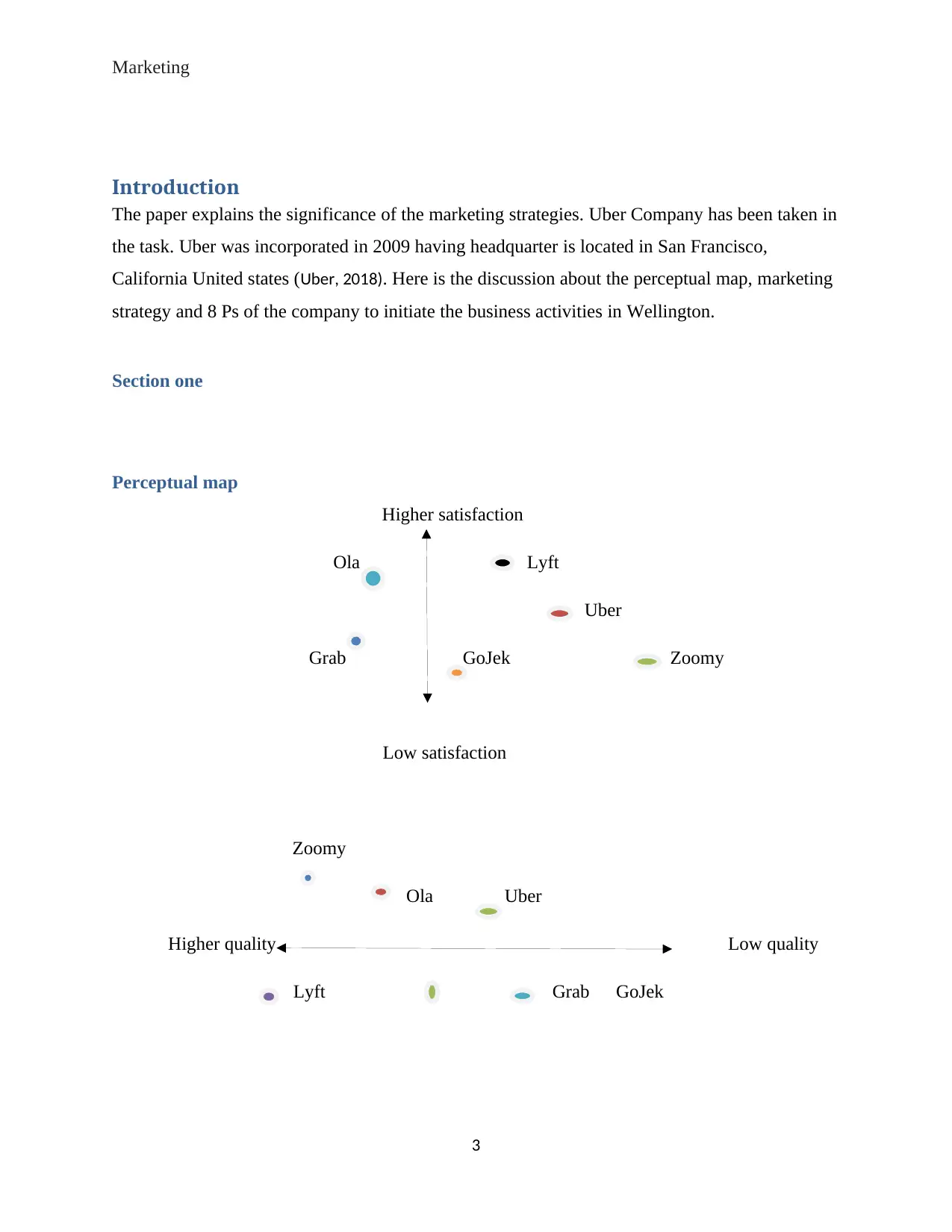
Marketing
Introduction
The paper explains the significance of the marketing strategies. Uber Company has been taken in
the task. Uber was incorporated in 2009 having headquarter is located in San Francisco,
California United states (Uber, 2018). Here is the discussion about the perceptual map, marketing
strategy and 8 Ps of the company to initiate the business activities in Wellington.
Section one
Perceptual map
Higher satisfaction
Ola Lyft
Uber
Grab GoJek Zoomy
Low satisfaction
Zoomy
Ola Uber
Higher quality Low quality
Lyft Grab GoJek
3
Introduction
The paper explains the significance of the marketing strategies. Uber Company has been taken in
the task. Uber was incorporated in 2009 having headquarter is located in San Francisco,
California United states (Uber, 2018). Here is the discussion about the perceptual map, marketing
strategy and 8 Ps of the company to initiate the business activities in Wellington.
Section one
Perceptual map
Higher satisfaction
Ola Lyft
Uber
Grab GoJek Zoomy
Low satisfaction
Zoomy
Ola Uber
Higher quality Low quality
Lyft Grab GoJek
3
⊘ This is a preview!⊘
Do you want full access?
Subscribe today to unlock all pages.

Trusted by 1+ million students worldwide
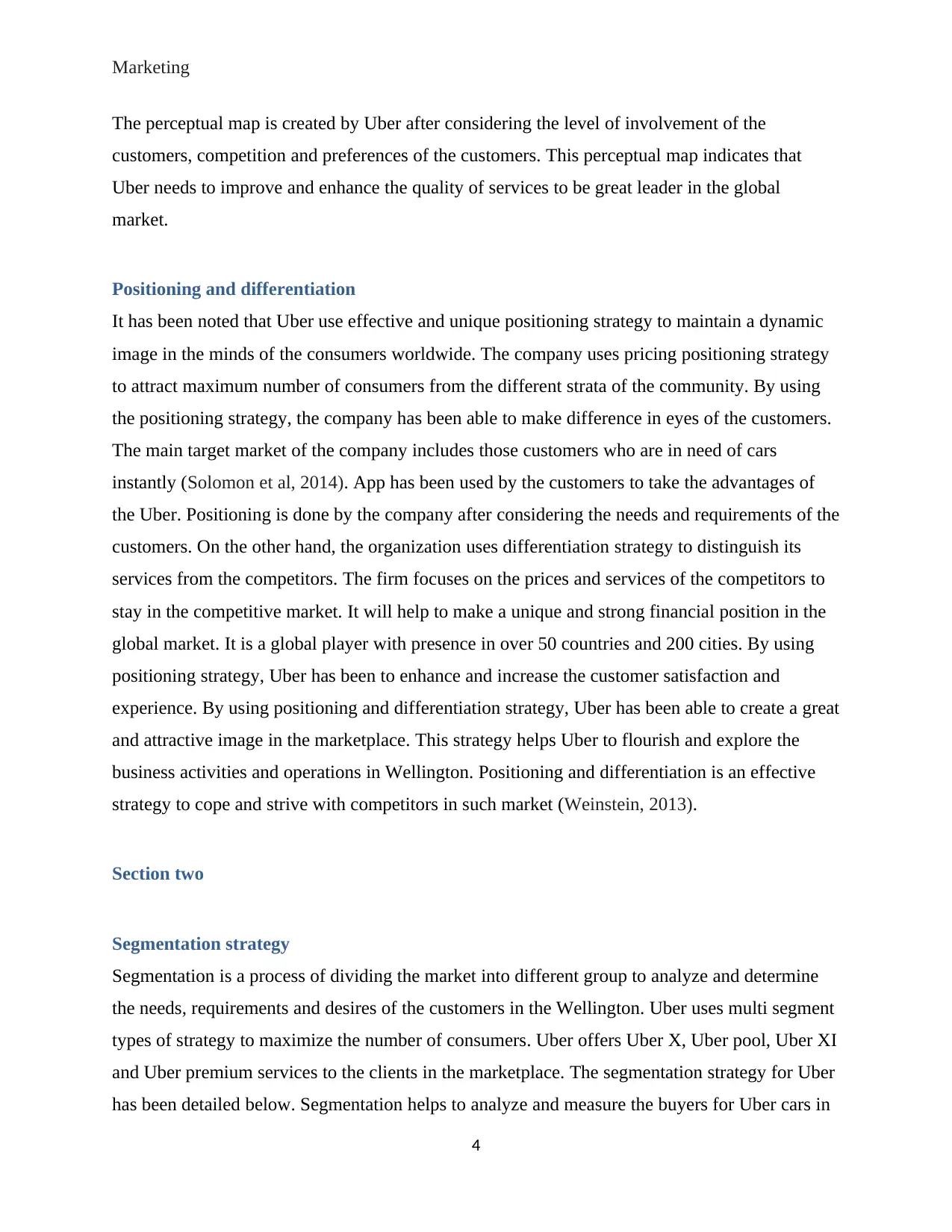
Marketing
The perceptual map is created by Uber after considering the level of involvement of the
customers, competition and preferences of the customers. This perceptual map indicates that
Uber needs to improve and enhance the quality of services to be great leader in the global
market.
Positioning and differentiation
It has been noted that Uber use effective and unique positioning strategy to maintain a dynamic
image in the minds of the consumers worldwide. The company uses pricing positioning strategy
to attract maximum number of consumers from the different strata of the community. By using
the positioning strategy, the company has been able to make difference in eyes of the customers.
The main target market of the company includes those customers who are in need of cars
instantly (Solomon et al, 2014). App has been used by the customers to take the advantages of
the Uber. Positioning is done by the company after considering the needs and requirements of the
customers. On the other hand, the organization uses differentiation strategy to distinguish its
services from the competitors. The firm focuses on the prices and services of the competitors to
stay in the competitive market. It will help to make a unique and strong financial position in the
global market. It is a global player with presence in over 50 countries and 200 cities. By using
positioning strategy, Uber has been to enhance and increase the customer satisfaction and
experience. By using positioning and differentiation strategy, Uber has been able to create a great
and attractive image in the marketplace. This strategy helps Uber to flourish and explore the
business activities and operations in Wellington. Positioning and differentiation is an effective
strategy to cope and strive with competitors in such market (Weinstein, 2013).
Section two
Segmentation strategy
Segmentation is a process of dividing the market into different group to analyze and determine
the needs, requirements and desires of the customers in the Wellington. Uber uses multi segment
types of strategy to maximize the number of consumers. Uber offers Uber X, Uber pool, Uber XI
and Uber premium services to the clients in the marketplace. The segmentation strategy for Uber
has been detailed below. Segmentation helps to analyze and measure the buyers for Uber cars in
4
The perceptual map is created by Uber after considering the level of involvement of the
customers, competition and preferences of the customers. This perceptual map indicates that
Uber needs to improve and enhance the quality of services to be great leader in the global
market.
Positioning and differentiation
It has been noted that Uber use effective and unique positioning strategy to maintain a dynamic
image in the minds of the consumers worldwide. The company uses pricing positioning strategy
to attract maximum number of consumers from the different strata of the community. By using
the positioning strategy, the company has been able to make difference in eyes of the customers.
The main target market of the company includes those customers who are in need of cars
instantly (Solomon et al, 2014). App has been used by the customers to take the advantages of
the Uber. Positioning is done by the company after considering the needs and requirements of the
customers. On the other hand, the organization uses differentiation strategy to distinguish its
services from the competitors. The firm focuses on the prices and services of the competitors to
stay in the competitive market. It will help to make a unique and strong financial position in the
global market. It is a global player with presence in over 50 countries and 200 cities. By using
positioning strategy, Uber has been to enhance and increase the customer satisfaction and
experience. By using positioning and differentiation strategy, Uber has been able to create a great
and attractive image in the marketplace. This strategy helps Uber to flourish and explore the
business activities and operations in Wellington. Positioning and differentiation is an effective
strategy to cope and strive with competitors in such market (Weinstein, 2013).
Section two
Segmentation strategy
Segmentation is a process of dividing the market into different group to analyze and determine
the needs, requirements and desires of the customers in the Wellington. Uber uses multi segment
types of strategy to maximize the number of consumers. Uber offers Uber X, Uber pool, Uber XI
and Uber premium services to the clients in the marketplace. The segmentation strategy for Uber
has been detailed below. Segmentation helps to analyze and measure the buyers for Uber cars in
4
Paraphrase This Document
Need a fresh take? Get an instant paraphrase of this document with our AI Paraphraser
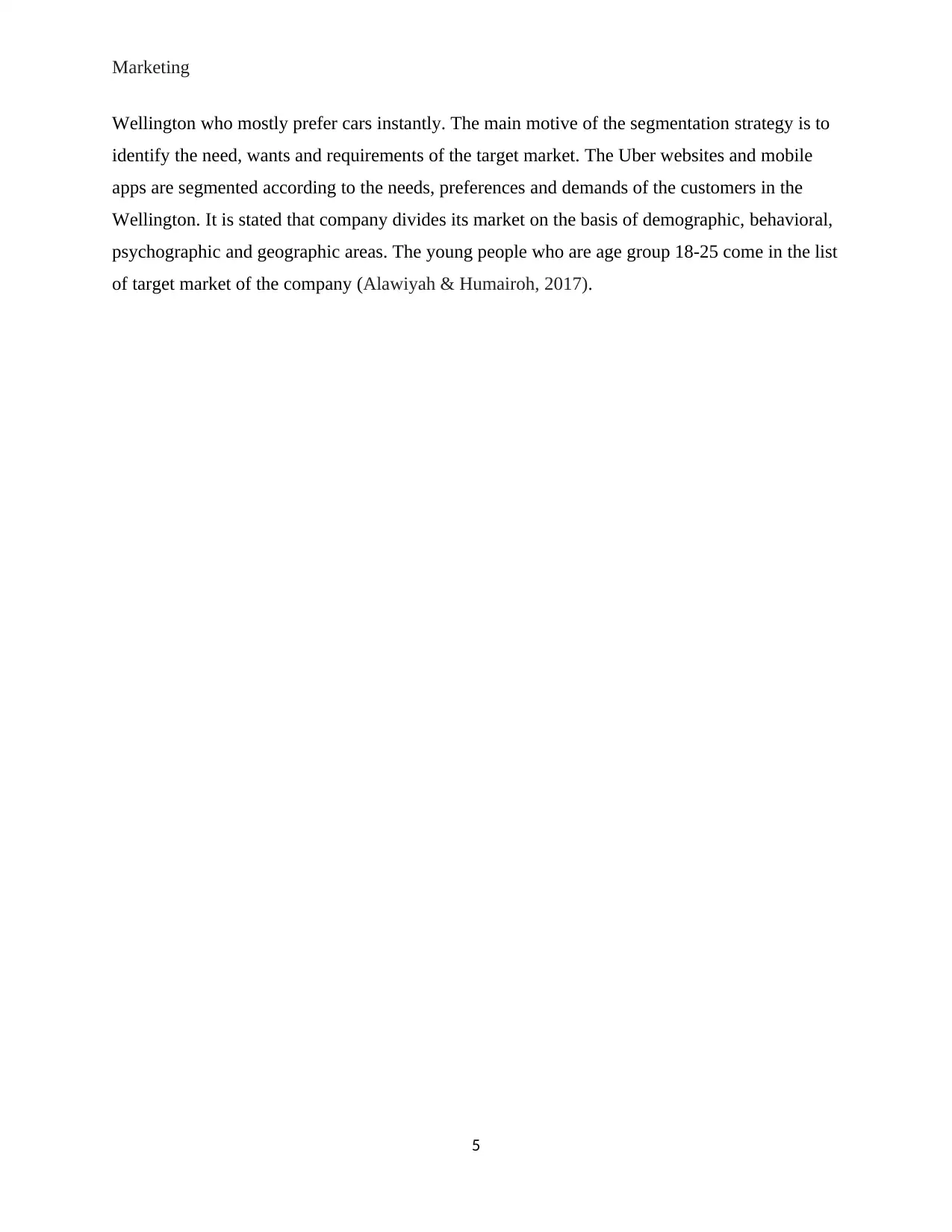
Marketing
Wellington who mostly prefer cars instantly. The main motive of the segmentation strategy is to
identify the need, wants and requirements of the target market. The Uber websites and mobile
apps are segmented according to the needs, preferences and demands of the customers in the
Wellington. It is stated that company divides its market on the basis of demographic, behavioral,
psychographic and geographic areas. The young people who are age group 18-25 come in the list
of target market of the company (Alawiyah & Humairoh, 2017).
5
Wellington who mostly prefer cars instantly. The main motive of the segmentation strategy is to
identify the need, wants and requirements of the target market. The Uber websites and mobile
apps are segmented according to the needs, preferences and demands of the customers in the
Wellington. It is stated that company divides its market on the basis of demographic, behavioral,
psychographic and geographic areas. The young people who are age group 18-25 come in the list
of target market of the company (Alawiyah & Humairoh, 2017).
5
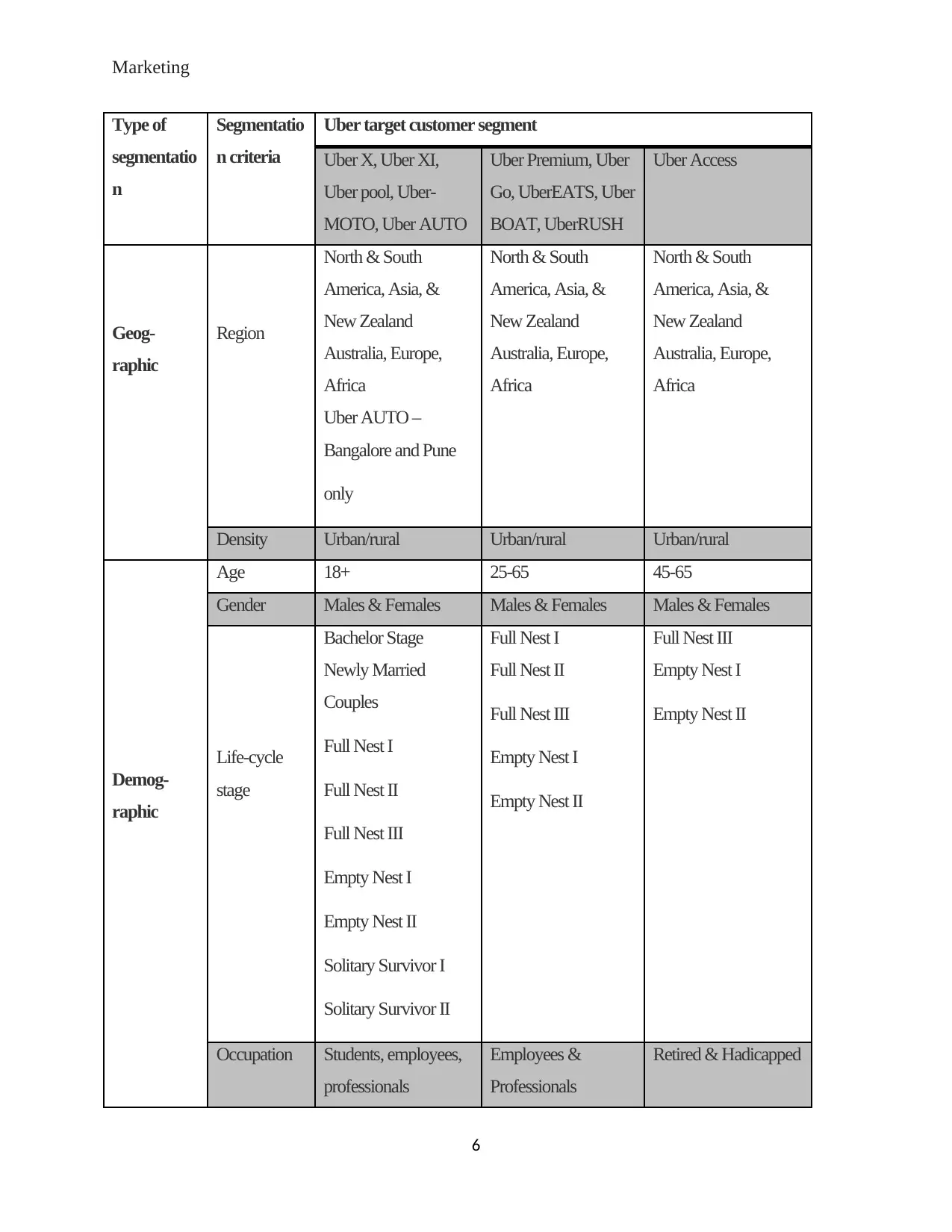
Marketing
Type of
segmentatio
n
Segmentatio
n criteria
Uber target customer segment
Uber X, Uber XI,
Uber pool, Uber-
MOTO, Uber AUTO
Uber Premium, Uber
Go, UberEATS, Uber
BOAT, UberRUSH
Uber Access
Geog-
raphic
Region
North & South
America, Asia, &
New Zealand
Australia, Europe,
Africa
Uber AUTO –
Bangalore and Pune
only
North & South
America, Asia, &
New Zealand
Australia, Europe,
Africa
North & South
America, Asia, &
New Zealand
Australia, Europe,
Africa
Density Urban/rural Urban/rural Urban/rural
Demog-
raphic
Age 18+ 25-65 45-65
Gender Males & Females Males & Females Males & Females
Life-cycle
stage
Bachelor Stage
Newly Married
Couples
Full Nest I
Full Nest II
Full Nest III
Empty Nest I
Empty Nest II
Solitary Survivor I
Solitary Survivor II
Full Nest I
Full Nest II
Full Nest III
Empty Nest I
Empty Nest II
Full Nest III
Empty Nest I
Empty Nest II
Occupation Students, employees,
professionals
Employees &
Professionals
Retired & Hadicapped
6
Type of
segmentatio
n
Segmentatio
n criteria
Uber target customer segment
Uber X, Uber XI,
Uber pool, Uber-
MOTO, Uber AUTO
Uber Premium, Uber
Go, UberEATS, Uber
BOAT, UberRUSH
Uber Access
Geog-
raphic
Region
North & South
America, Asia, &
New Zealand
Australia, Europe,
Africa
Uber AUTO –
Bangalore and Pune
only
North & South
America, Asia, &
New Zealand
Australia, Europe,
Africa
North & South
America, Asia, &
New Zealand
Australia, Europe,
Africa
Density Urban/rural Urban/rural Urban/rural
Demog-
raphic
Age 18+ 25-65 45-65
Gender Males & Females Males & Females Males & Females
Life-cycle
stage
Bachelor Stage
Newly Married
Couples
Full Nest I
Full Nest II
Full Nest III
Empty Nest I
Empty Nest II
Solitary Survivor I
Solitary Survivor II
Full Nest I
Full Nest II
Full Nest III
Empty Nest I
Empty Nest II
Full Nest III
Empty Nest I
Empty Nest II
Occupation Students, employees,
professionals
Employees &
Professionals
Retired & Hadicapped
6
⊘ This is a preview!⊘
Do you want full access?
Subscribe today to unlock all pages.

Trusted by 1+ million students worldwide
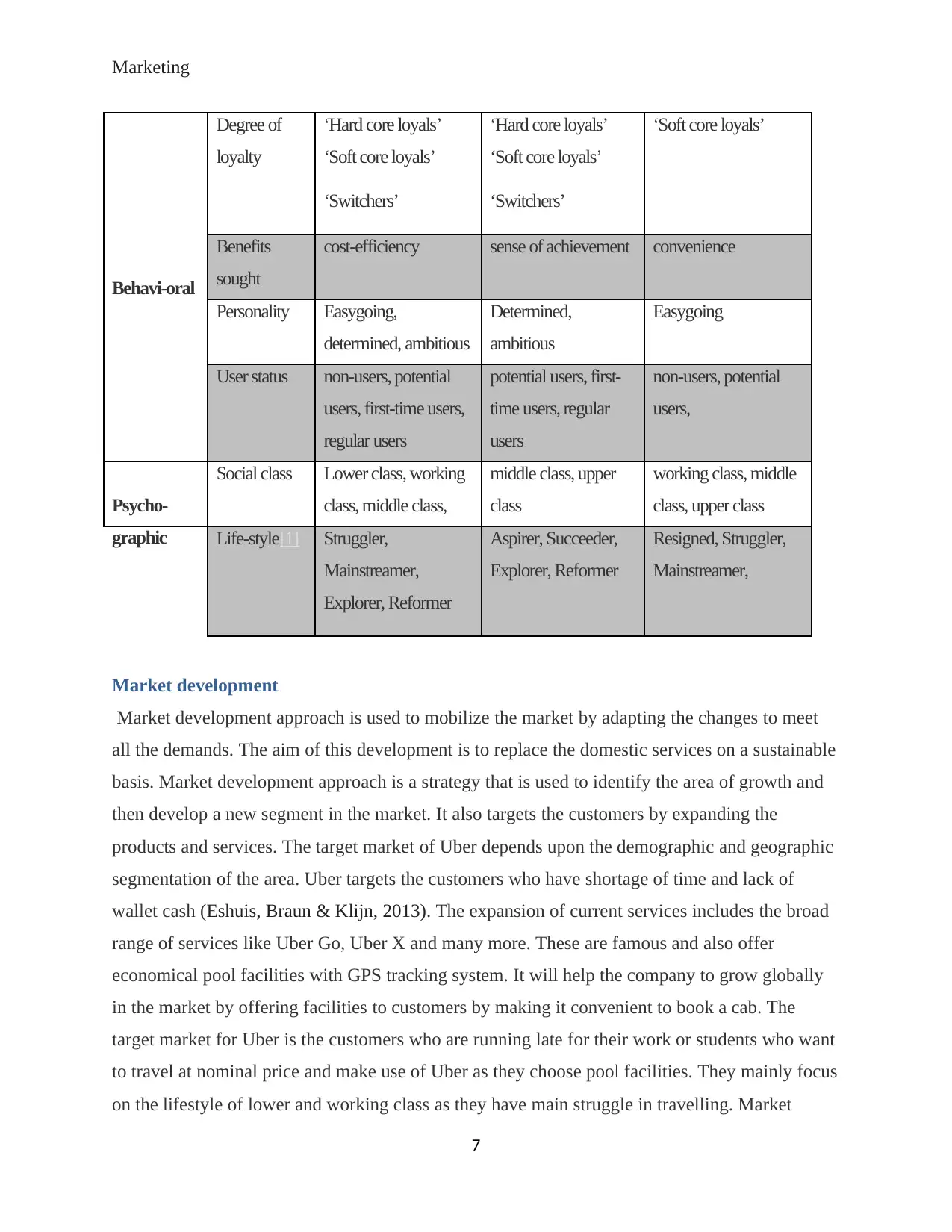
Marketing
Behavi-oral
Degree of
loyalty
‘Hard core loyals’
‘Soft core loyals’
‘Switchers’
‘Hard core loyals’
‘Soft core loyals’
‘Switchers’
‘Soft core loyals’
Benefits
sought
cost-efficiency sense of achievement convenience
Personality Easygoing,
determined, ambitious
Determined,
ambitious
Easygoing
User status non-users, potential
users, first-time users,
regular users
potential users, first-
time users, regular
users
non-users, potential
users,
Psycho-
graphic
Social class Lower class, working
class, middle class,
middle class, upper
class
working class, middle
class, upper class
Life-style[1] Struggler,
Mainstreamer,
Explorer, Reformer
Aspirer, Succeeder,
Explorer, Reformer
Resigned, Struggler,
Mainstreamer,
Market development
Market development approach is used to mobilize the market by adapting the changes to meet
all the demands. The aim of this development is to replace the domestic services on a sustainable
basis. Market development approach is a strategy that is used to identify the area of growth and
then develop a new segment in the market. It also targets the customers by expanding the
products and services. The target market of Uber depends upon the demographic and geographic
segmentation of the area. Uber targets the customers who have shortage of time and lack of
wallet cash (Eshuis, Braun & Klijn, 2013). The expansion of current services includes the broad
range of services like Uber Go, Uber X and many more. These are famous and also offer
economical pool facilities with GPS tracking system. It will help the company to grow globally
in the market by offering facilities to customers by making it convenient to book a cab. The
target market for Uber is the customers who are running late for their work or students who want
to travel at nominal price and make use of Uber as they choose pool facilities. They mainly focus
on the lifestyle of lower and working class as they have main struggle in travelling. Market
7
Behavi-oral
Degree of
loyalty
‘Hard core loyals’
‘Soft core loyals’
‘Switchers’
‘Hard core loyals’
‘Soft core loyals’
‘Switchers’
‘Soft core loyals’
Benefits
sought
cost-efficiency sense of achievement convenience
Personality Easygoing,
determined, ambitious
Determined,
ambitious
Easygoing
User status non-users, potential
users, first-time users,
regular users
potential users, first-
time users, regular
users
non-users, potential
users,
Psycho-
graphic
Social class Lower class, working
class, middle class,
middle class, upper
class
working class, middle
class, upper class
Life-style[1] Struggler,
Mainstreamer,
Explorer, Reformer
Aspirer, Succeeder,
Explorer, Reformer
Resigned, Struggler,
Mainstreamer,
Market development
Market development approach is used to mobilize the market by adapting the changes to meet
all the demands. The aim of this development is to replace the domestic services on a sustainable
basis. Market development approach is a strategy that is used to identify the area of growth and
then develop a new segment in the market. It also targets the customers by expanding the
products and services. The target market of Uber depends upon the demographic and geographic
segmentation of the area. Uber targets the customers who have shortage of time and lack of
wallet cash (Eshuis, Braun & Klijn, 2013). The expansion of current services includes the broad
range of services like Uber Go, Uber X and many more. These are famous and also offer
economical pool facilities with GPS tracking system. It will help the company to grow globally
in the market by offering facilities to customers by making it convenient to book a cab. The
target market for Uber is the customers who are running late for their work or students who want
to travel at nominal price and make use of Uber as they choose pool facilities. They mainly focus
on the lifestyle of lower and working class as they have main struggle in travelling. Market
7
Paraphrase This Document
Need a fresh take? Get an instant paraphrase of this document with our AI Paraphraser
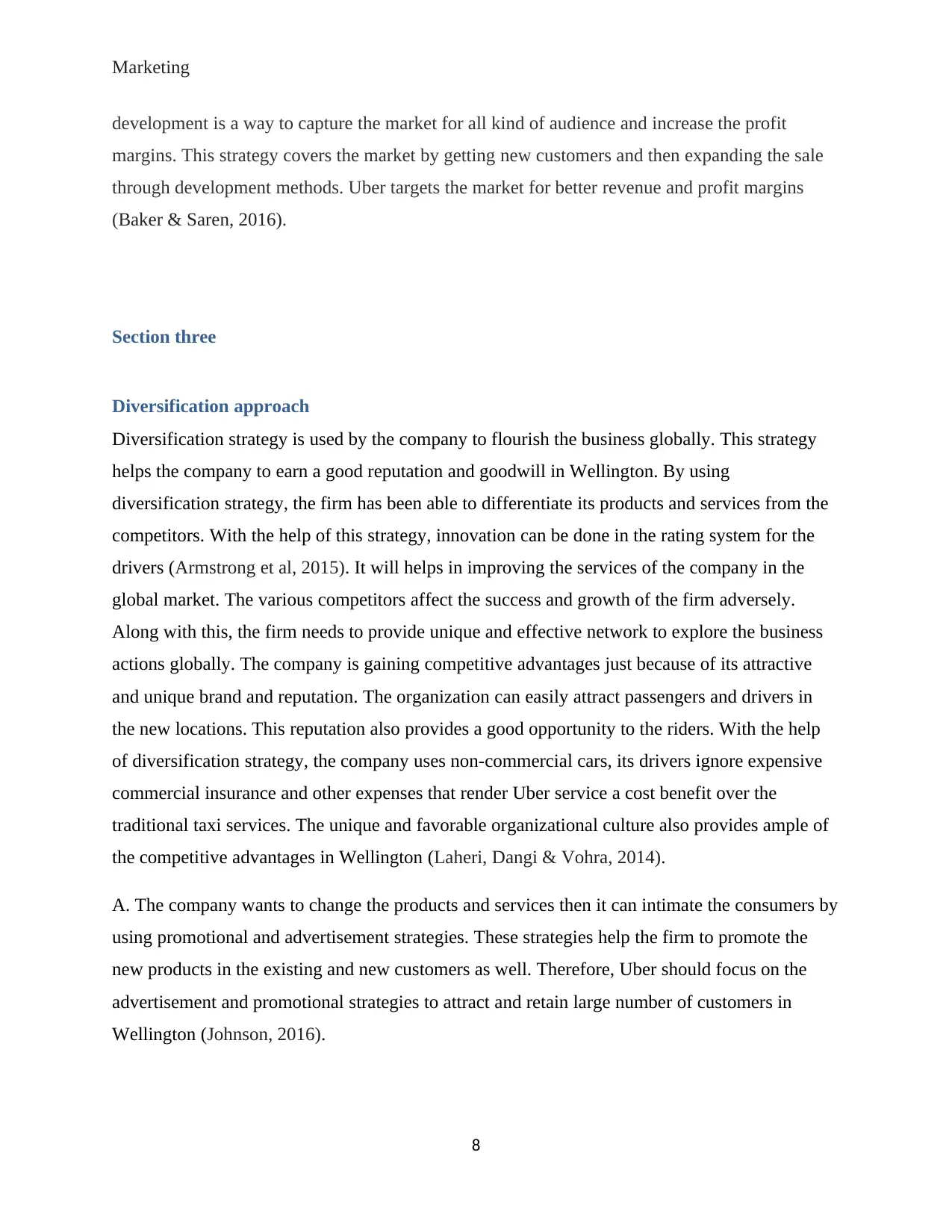
Marketing
development is a way to capture the market for all kind of audience and increase the profit
margins. This strategy covers the market by getting new customers and then expanding the sale
through development methods. Uber targets the market for better revenue and profit margins
(Baker & Saren, 2016).
Section three
Diversification approach
Diversification strategy is used by the company to flourish the business globally. This strategy
helps the company to earn a good reputation and goodwill in Wellington. By using
diversification strategy, the firm has been able to differentiate its products and services from the
competitors. With the help of this strategy, innovation can be done in the rating system for the
drivers (Armstrong et al, 2015). It will helps in improving the services of the company in the
global market. The various competitors affect the success and growth of the firm adversely.
Along with this, the firm needs to provide unique and effective network to explore the business
actions globally. The company is gaining competitive advantages just because of its attractive
and unique brand and reputation. The organization can easily attract passengers and drivers in
the new locations. This reputation also provides a good opportunity to the riders. With the help
of diversification strategy, the company uses non-commercial cars, its drivers ignore expensive
commercial insurance and other expenses that render Uber service a cost benefit over the
traditional taxi services. The unique and favorable organizational culture also provides ample of
the competitive advantages in Wellington (Laheri, Dangi & Vohra, 2014).
A. The company wants to change the products and services then it can intimate the consumers by
using promotional and advertisement strategies. These strategies help the firm to promote the
new products in the existing and new customers as well. Therefore, Uber should focus on the
advertisement and promotional strategies to attract and retain large number of customers in
Wellington (Johnson, 2016).
8
development is a way to capture the market for all kind of audience and increase the profit
margins. This strategy covers the market by getting new customers and then expanding the sale
through development methods. Uber targets the market for better revenue and profit margins
(Baker & Saren, 2016).
Section three
Diversification approach
Diversification strategy is used by the company to flourish the business globally. This strategy
helps the company to earn a good reputation and goodwill in Wellington. By using
diversification strategy, the firm has been able to differentiate its products and services from the
competitors. With the help of this strategy, innovation can be done in the rating system for the
drivers (Armstrong et al, 2015). It will helps in improving the services of the company in the
global market. The various competitors affect the success and growth of the firm adversely.
Along with this, the firm needs to provide unique and effective network to explore the business
actions globally. The company is gaining competitive advantages just because of its attractive
and unique brand and reputation. The organization can easily attract passengers and drivers in
the new locations. This reputation also provides a good opportunity to the riders. With the help
of diversification strategy, the company uses non-commercial cars, its drivers ignore expensive
commercial insurance and other expenses that render Uber service a cost benefit over the
traditional taxi services. The unique and favorable organizational culture also provides ample of
the competitive advantages in Wellington (Laheri, Dangi & Vohra, 2014).
A. The company wants to change the products and services then it can intimate the consumers by
using promotional and advertisement strategies. These strategies help the firm to promote the
new products in the existing and new customers as well. Therefore, Uber should focus on the
advertisement and promotional strategies to attract and retain large number of customers in
Wellington (Johnson, 2016).
8
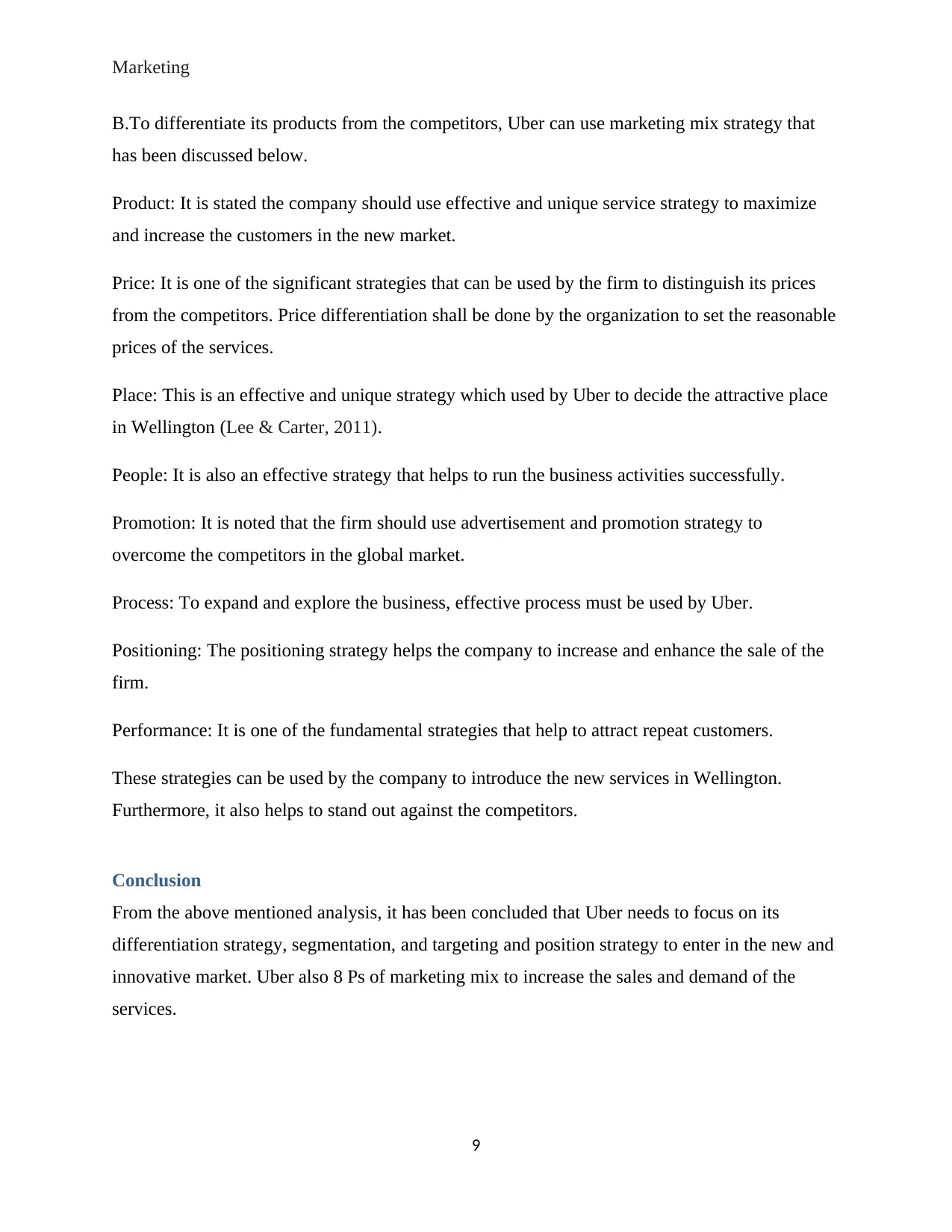
Marketing
B.To differentiate its products from the competitors, Uber can use marketing mix strategy that
has been discussed below.
Product: It is stated the company should use effective and unique service strategy to maximize
and increase the customers in the new market.
Price: It is one of the significant strategies that can be used by the firm to distinguish its prices
from the competitors. Price differentiation shall be done by the organization to set the reasonable
prices of the services.
Place: This is an effective and unique strategy which used by Uber to decide the attractive place
in Wellington (Lee & Carter, 2011).
People: It is also an effective strategy that helps to run the business activities successfully.
Promotion: It is noted that the firm should use advertisement and promotion strategy to
overcome the competitors in the global market.
Process: To expand and explore the business, effective process must be used by Uber.
Positioning: The positioning strategy helps the company to increase and enhance the sale of the
firm.
Performance: It is one of the fundamental strategies that help to attract repeat customers.
These strategies can be used by the company to introduce the new services in Wellington.
Furthermore, it also helps to stand out against the competitors.
Conclusion
From the above mentioned analysis, it has been concluded that Uber needs to focus on its
differentiation strategy, segmentation, and targeting and position strategy to enter in the new and
innovative market. Uber also 8 Ps of marketing mix to increase the sales and demand of the
services.
9
B.To differentiate its products from the competitors, Uber can use marketing mix strategy that
has been discussed below.
Product: It is stated the company should use effective and unique service strategy to maximize
and increase the customers in the new market.
Price: It is one of the significant strategies that can be used by the firm to distinguish its prices
from the competitors. Price differentiation shall be done by the organization to set the reasonable
prices of the services.
Place: This is an effective and unique strategy which used by Uber to decide the attractive place
in Wellington (Lee & Carter, 2011).
People: It is also an effective strategy that helps to run the business activities successfully.
Promotion: It is noted that the firm should use advertisement and promotion strategy to
overcome the competitors in the global market.
Process: To expand and explore the business, effective process must be used by Uber.
Positioning: The positioning strategy helps the company to increase and enhance the sale of the
firm.
Performance: It is one of the fundamental strategies that help to attract repeat customers.
These strategies can be used by the company to introduce the new services in Wellington.
Furthermore, it also helps to stand out against the competitors.
Conclusion
From the above mentioned analysis, it has been concluded that Uber needs to focus on its
differentiation strategy, segmentation, and targeting and position strategy to enter in the new and
innovative market. Uber also 8 Ps of marketing mix to increase the sales and demand of the
services.
9
⊘ This is a preview!⊘
Do you want full access?
Subscribe today to unlock all pages.

Trusted by 1+ million students worldwide
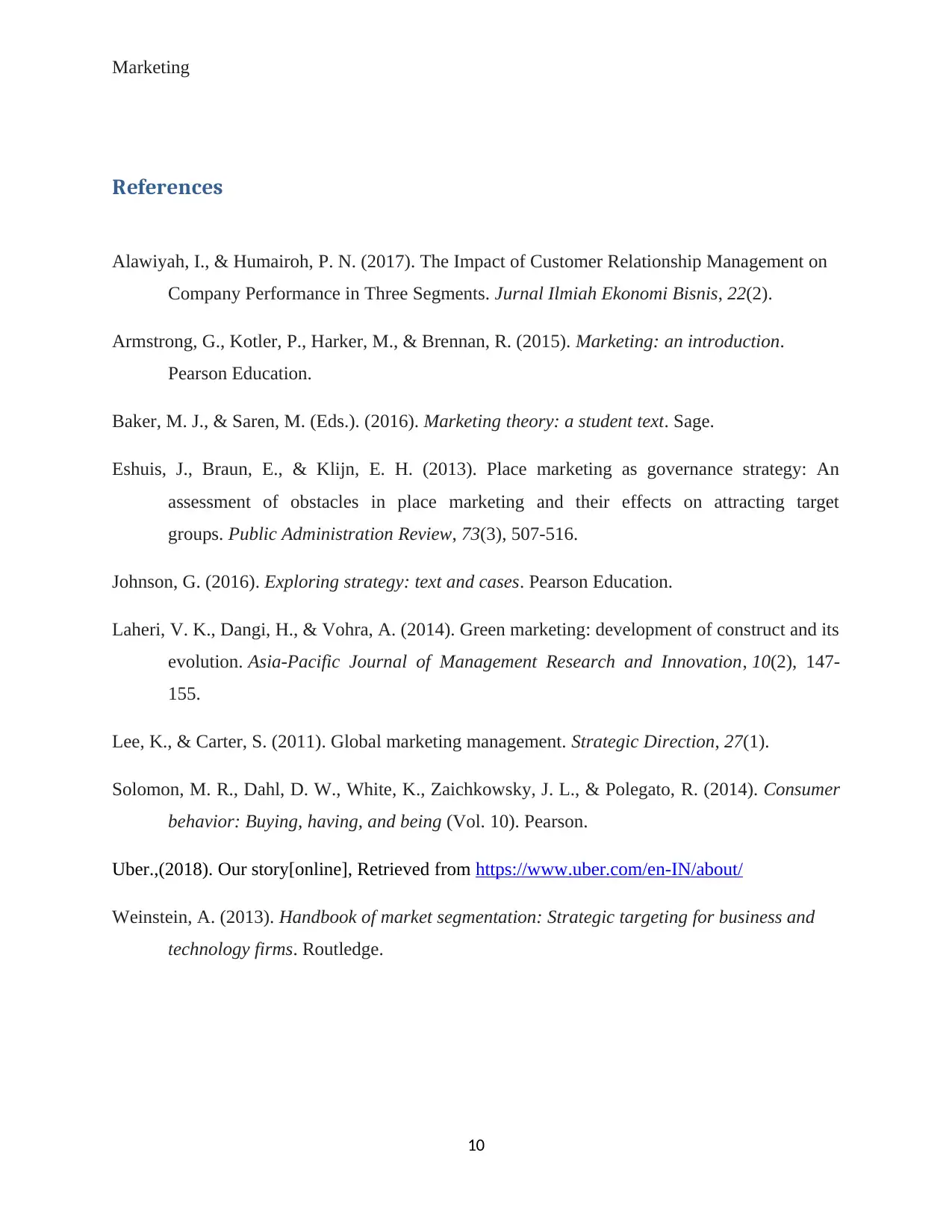
Marketing
References
Alawiyah, I., & Humairoh, P. N. (2017). The Impact of Customer Relationship Management on
Company Performance in Three Segments. Jurnal Ilmiah Ekonomi Bisnis, 22(2).
Armstrong, G., Kotler, P., Harker, M., & Brennan, R. (2015). Marketing: an introduction.
Pearson Education.
Baker, M. J., & Saren, M. (Eds.). (2016). Marketing theory: a student text. Sage.
Eshuis, J., Braun, E., & Klijn, E. H. (2013). Place marketing as governance strategy: An
assessment of obstacles in place marketing and their effects on attracting target
groups. Public Administration Review, 73(3), 507-516.
Johnson, G. (2016). Exploring strategy: text and cases. Pearson Education.
Laheri, V. K., Dangi, H., & Vohra, A. (2014). Green marketing: development of construct and its
evolution. Asia-Pacific Journal of Management Research and Innovation, 10(2), 147-
155.
Lee, K., & Carter, S. (2011). Global marketing management. Strategic Direction, 27(1).
Solomon, M. R., Dahl, D. W., White, K., Zaichkowsky, J. L., & Polegato, R. (2014). Consumer
behavior: Buying, having, and being (Vol. 10). Pearson.
Uber.,(2018). Our story[online], Retrieved from https://www.uber.com/en-IN/about/
Weinstein, A. (2013). Handbook of market segmentation: Strategic targeting for business and
technology firms. Routledge.
10
References
Alawiyah, I., & Humairoh, P. N. (2017). The Impact of Customer Relationship Management on
Company Performance in Three Segments. Jurnal Ilmiah Ekonomi Bisnis, 22(2).
Armstrong, G., Kotler, P., Harker, M., & Brennan, R. (2015). Marketing: an introduction.
Pearson Education.
Baker, M. J., & Saren, M. (Eds.). (2016). Marketing theory: a student text. Sage.
Eshuis, J., Braun, E., & Klijn, E. H. (2013). Place marketing as governance strategy: An
assessment of obstacles in place marketing and their effects on attracting target
groups. Public Administration Review, 73(3), 507-516.
Johnson, G. (2016). Exploring strategy: text and cases. Pearson Education.
Laheri, V. K., Dangi, H., & Vohra, A. (2014). Green marketing: development of construct and its
evolution. Asia-Pacific Journal of Management Research and Innovation, 10(2), 147-
155.
Lee, K., & Carter, S. (2011). Global marketing management. Strategic Direction, 27(1).
Solomon, M. R., Dahl, D. W., White, K., Zaichkowsky, J. L., & Polegato, R. (2014). Consumer
behavior: Buying, having, and being (Vol. 10). Pearson.
Uber.,(2018). Our story[online], Retrieved from https://www.uber.com/en-IN/about/
Weinstein, A. (2013). Handbook of market segmentation: Strategic targeting for business and
technology firms. Routledge.
10
1 out of 10
Related Documents
Your All-in-One AI-Powered Toolkit for Academic Success.
+13062052269
info@desklib.com
Available 24*7 on WhatsApp / Email
![[object Object]](/_next/static/media/star-bottom.7253800d.svg)
Unlock your academic potential
Copyright © 2020–2025 A2Z Services. All Rights Reserved. Developed and managed by ZUCOL.





